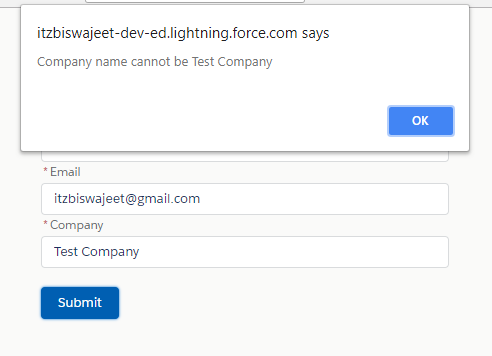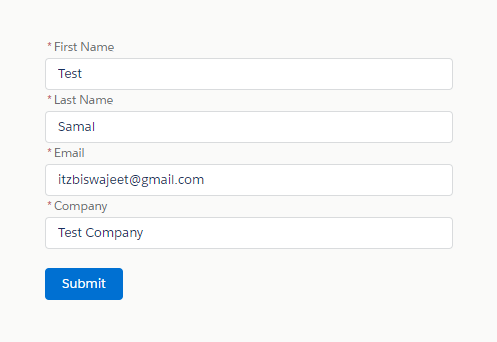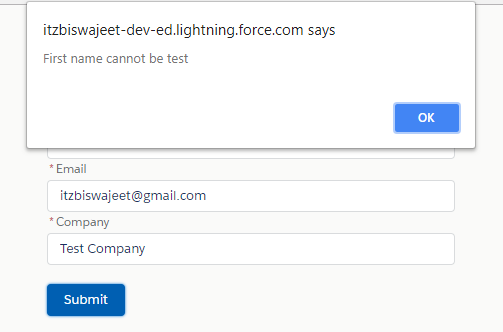Handle Trigger and Validation Rule Error in Lightning Component
Sometimes we can have a requirement to display validation rule error or apex trigger error messages, on save of record in Lightning Component. We can handle those errors from apex controller and can throw messages to Lightning Component. In lightning response object though the state value comes as ERROR but the message in the error object always says ‘Internal Server Error”. Here is an example to handle the Trigger and Validation Rule Error in apex controller to show error messages in Lightning Component.
In below example I’ve used Lead object FirstName, LastName, Email & Company Field in lightning component to create record. And I’ve created a validation rule and a trigger validation on Lead object.
1. Validation rule for Company field (Company cannot be Test Company).

2. In below Trigger I’m checking if FirstName field value is “Test” then it will throw error.
trigger LeadTrigger on Lead (before insert, before update) {
for(Lead obj :Trigger.new){
if(obj.FirstName == 'Test'){
obj.FirstName.addError('First name cannot be test');
}
}
}
Apex Controller:
public class SampleAuraController {
@AuraEnabled
Public static void createLead(Lead objLead){
String msg = '';
try{
//Insert Lead Record
insert objLead;
}catch(DmlException e){
//Any type of Validation Rule error message, Required field missing error message, Trigger error message etc..
//we can get from DmlException
//Get All DML Messages
for (Integer i = 0; i < e.getNumDml(); i++) {
//Get Validation Rule & Trigger Error Messages
msg =+ e.getDmlMessage(i) + '\n' ;
}
//throw DML exception message
throw new AuraHandledException(msg);
}catch(Exception e){
//throw all other exception message
throw new AuraHandledException(e.getMessage());
}
finally {
}
}
}
Lightning Component:
<!--Sample.cmp-->
<aura:component controller="SampleAuraController" implements="flexipage:availableForAllPageTypes,force:appHostable">
<!--Declare Attributes-->
<aura:attribute name="isSpinner" type="boolean" default="false"/>
<aura:attribute name="objLead" type="Lead" default="{'sobjectType':'Lead',
'FirstName': '',
'LastName': '',
'Email': '',
'Company': ''}"/>
<!--Component Start-->
<div class="slds-m-around--xx-large">
<div class="container-fluid">
<div class="form-group">
<lightning:input name="fname" type="text" maxlength="50" required="true" label="First Name" value="{!v.objLead.FirstName}" />
</div>
<div class="form-group">
<lightning:input name="lname" type="text" maxlength="50" required="true" label="Last Name" value="{!v.objLead.LastName}" />
</div>
<div class="form-group">
<lightning:input name="emailId" type="email" maxlength="100" required="true" label="Email" value="{!v.objLead.Email}" />
</div>
<div class="form-group">
<lightning:input name="company" type="text" maxlength="50" required="true" label="Company" value="{!v.objLead.Company}" />
</div>
</div>
<br/>
<lightning:button variant="brand" label="Submit" onclick="{!c.handleLeadSave}" />
<lightning:button label="Cancel" onclick="{!c.handleCancel}"/>
</div>
<!--Component End-->
</aura:component>
Lightning JS Controller:
({
//Handle Lead Save
handleLeadSave : function(component, event, helper) {
var objLead = component.get("v.objLead");
var action = component.get("c.createLead");
action.setParams({
objLead : objLead
});
action.setCallback(this,function(a){
var state = a.getState();
if(state === "SUCCESS"){
alert('Record is Created Successfully');
} else if(state === "ERROR"){
var errors = action.getError();
if (errors) {
if (errors[0] && errors[0].message) {
alert(errors[0].message);
}
}
}else if (status === "INCOMPLETE") {
alert('No response from server or client is offline.');
}
});
$A.enqueueAction(action);
}
})
Validation Rule Error Message:




